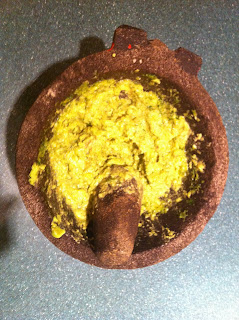
What do you need
-
1 chicken
- salt, kosher is the best
- pepper, freshly ground
- 1 or 2 lemons sliced
- juice of 1/2 lemon
- at least 5 sprigs of thyme
I have tried many times to create the perfect roasted chicken. Skin on vs skin off, whole chicken vs cut up chicken, brining vs marinating, whole chicken vs de-boned chicken: you name it; I've tried it. Nothing really that good, until I discovered the tried and true method of seasoning under the skin. That's when roasted chicken took off. Thank you, Jacques Pepin, you rock!
Under the skin seasoning is good for a couple of things. The skin becomes crispy and nicely browned, and the seasoning penetrates the meat all the way to the bones. There is a lof of fat under the skin, which helps to keep the meat juicy and moist, so you don't need any oil or butter anymore. Also the bones give a lot of flavor to the meat, so bone-in is definitely the way to go.
The technique for "under the skin seasoning" not difficult, but as always there is some work involved in it. You have to be gentile otherwise the skin breaks. If your chicken was deep frozen, make sure the chicken is completely thawed before you start. The skin brakes easily when the chicken is not completely thawed.
Start at the breast side of the chicken at the opening to the cavity. Stick your figures under the skin and gentily loosen up the skin al the way to the neck. Then work your way to the thighs and drum sticks, loosening that skin as well. When the breast side is completely done, turn the chicken over and loosen up the back side.
I found that using your fingers gives you the most control and prevent breakage vs using a chop stick or another device. Just make sure you wash your hands very well afterwards to prevent contaminating other foods.
Once the skin is completely loosened up, the seasoning starts.
First up: salt! Set salt aside in a bowl or plate and disregard the remaining salt when you are done. Again to prevent contamination. Use your fingers to pat the entire chicken under the skin with salt and rub the salt in a little bit. This will accelerate the absorption of the salt. Salting the chicken is important as the salt creates pores and tunnels into the meat so that the rest of the aromatics can penetrate the meat all the way to the bones. Also, put salt in the cavity of the chicken, so the salt can work it's magic on both ends.
Next up: pepper! Again pat the bird with pepper and rub in and put a fair amount in the cavity.
Finally the rest of the seasoning. Squeeze half a lemon and message the chicken with the lemon juice. Cut the lemon into slices and stick the slices under the skin: 3 slices under the breast and 1 each under the drum sticks. Stick a fair amount of thyme everywhere under the skin and in the cavity.
Now the waiting starts. Cover the chicken with plastic wrap and stick it in the fridge. Let marinate at least 6 hours, overnight is even better.
When you are ready to roast, cut out the backbone of the chicken with a sharp knife and crack the breast bone, leaving you with a "butterflied" bird. The butterflying ensures the most cooking surfaces and makes the entire bird equal in height. Equal height means equal cooking time and no undercooked dark meat while the white meat is overcooked and dry.
Preheat your oven to 450 degrees and when the oven is hot, lay the chicken on a baking sheet or roasting pan and douse the chicken with a little bit of white wine, vintage of your choice. Bear in mind, that you only need the wine flavor, so cheap cooking wine will do just fine... In the oven with the bird.
After 30 minutes or so, the skin will be nicely golden brown and delicious. Reduce the heat to 350 degrees and cook until done. For a 3 pound chicken the total cook time is appr. 50 minutes, a 5 pound chicken 60 - 70 minutes.
I have a couple of oven thermometers and they work very well. Stick the probe into the thickest part of the thigh and cook until the internal temperature reaches 150 degrees. Do not cook the bird all the way to the recommended temperature of 160 degrees! When you take the bird out of the oven, the carry-over-cooking will cook the meat at least 5 degrees more. You want a juicy chicken not a piece of rubber!!
Actually lately I employ the "chopstick method" for done-ness checking: Stick a chopstick into the thickest part of the thigh. When the juices run clear, the chicken is done. If you see pink or red fluids, roast longer.






